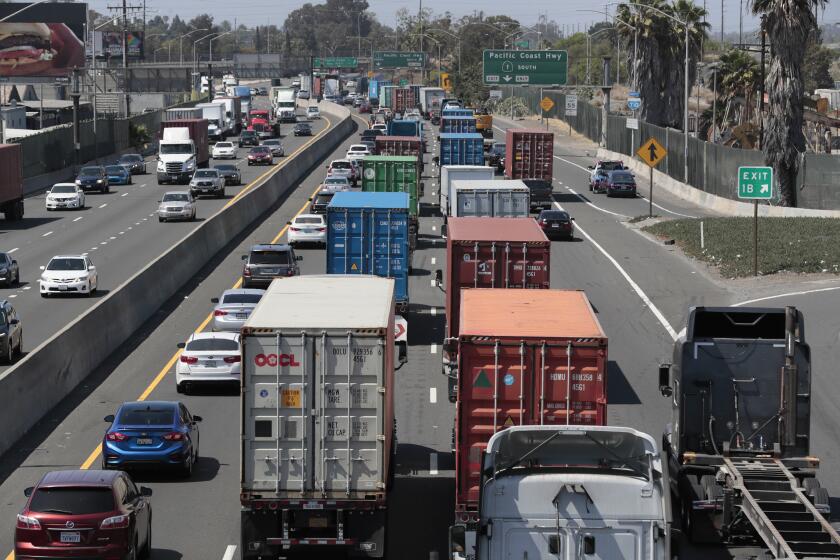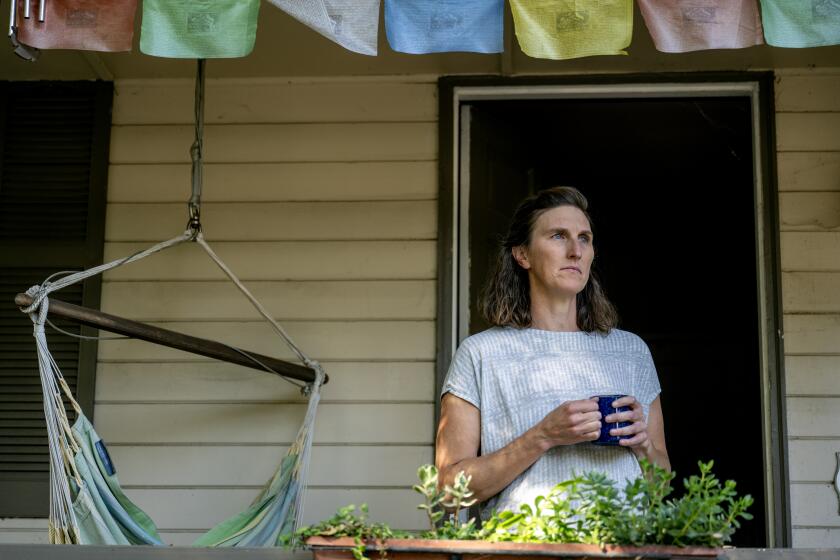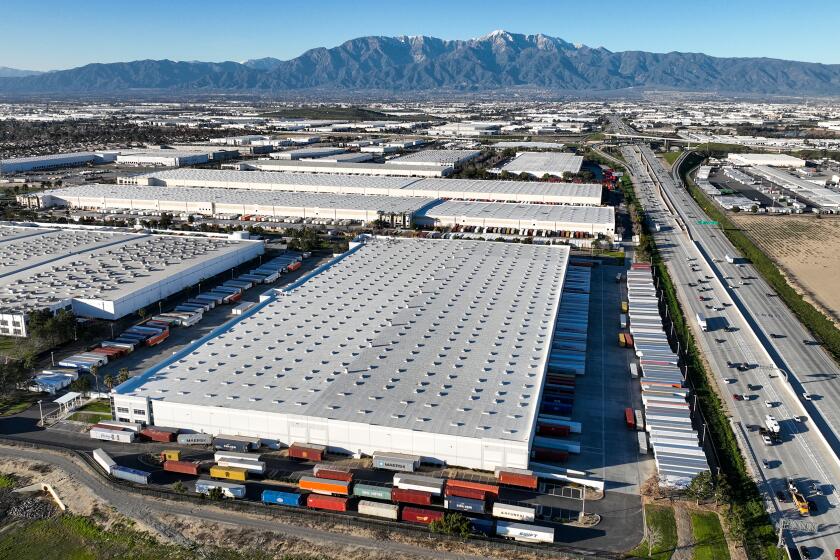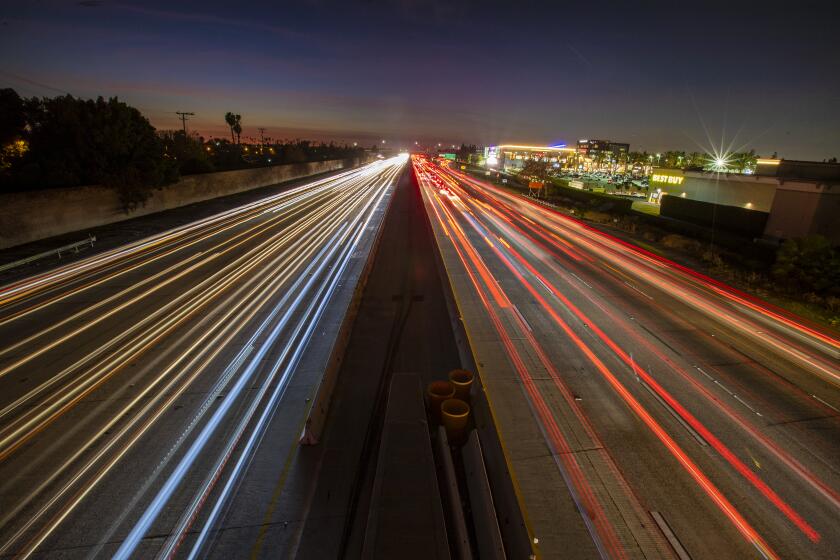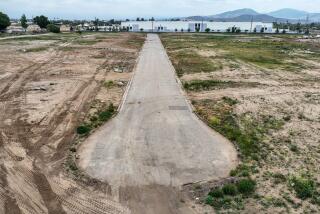California says it prioritizes climate goals over freeway widening. So why is the 15 Freeway getting more lanes?

- Share via
Express lanes on eight miles of the truck-choked Interstate 15 will break ground this year and, officials promise, speed up commuters’ slog through the Inland Empire’s ever-growing sprawl of warehouses, subdivisions and polluted air.
But its contentious approval by the California Transportation Commission last month exposed a deepening rift in the state between its climate goals and the list of freeway widening projects that some say are gliding through without scrutiny and threatening the health of the people who live near them.
The U.S. Environmental Protection Agency is now looking into allegations that the San Bernardino County Transportation Authority and the California Department of Transportation may have misled it about the potential environmental harm the project could cause communities that breathe in some of the nation’s worst air. Both say the project was vetted thoroughly and is sound.
In the Inland Empire, the $388-million express lane project is the centerpiece of a plan to improve traffic along one of the nation’s most congested freight corridors, where commuters going to school or work must navigate the deluge of big rigs carrying goods to and from the area’s massive distribution centers. The new lanes would run roughly from the 60 Freeway to a few miles south of the 210 Freeway and connect to Riverside County’s toll lanes.
Plans for the lanes had been moving along for more than a decade with widespread support from federal, state and local agencies — until December, when Joseph Lyou, who was then a member of the California Transportation Commission, raised concerns about providing it $202 million in state funds.
Lyou is president of the Coalition for Clean Air and a former board member of the South Coast Air Quality Management District. He said he was “at the end of his patience” with traffic-inducing freeway expansions that California officials had pledged to end to meet ambitious climate goals.
At the end of a daylong meeting in Riverside on Dec. 7, he asked how planners could conclude that new lanes wouldn’t cause more truck traffic in one of the nation’s worst freight bottlenecks. The analysis, he said, must be flawed.
“At a place like this Inland Empire community where warehouses pop up every other day — million-square-foot warehouses,” he told the commission. “Providing that additional capacity on that freeway influences whether we get more of those million-square-foot warehouses, and it will and can induce truck traffic.”
It was late in the day, and several commissioners had already left the chambers.
“You know, we few of us here left all recognize this issue of induced traffic,” he said. “And despite that, at every meeting, we are asked to make one or two exceptions to this rule, with this knowledge, and we widen freeway projects after widening freeway projects.”
The concept of induced traffic means the more space made for vehicles, the more drivers will come, making congestion worse and increasing greenhouse gas and health-harming pollutants. The $1-billion 405 Freeway expansion through the Sepulveda Pass is an example. It was supposed to ease traffic , but it eventually grew worse, studies found.
California transportation leaders want to wind down freeway widenings, but organized labor groups say road projects should continue.
Lyou didn’t expect anyone to pay much attention to his objections. A longtime environmental justice advocate, he said he is used to taking on powerful institutions and being ignored and even lied to.
But to his surprise that evening, two other commissioners, Adonia Lugo and Darnell Grisby, both appointees of Gov. Gavin Newsom, joined him in voting against the project. The 3-3 vote essentially stalled the plan.
The decision reverberated up and down the state.
“This may be a tipping point,” said Jeanie Ward-Waller, a former Caltrans executive and whistleblower who has accused the agency of skirting regulations to expand roads. “A lot of leaders have been saying for a long time that we don’t really do highway widening anymore, but they very much are still in the pipeline.”
Last year, Ward-Waller was demoted after accusing the $20-billion agency of bypassing rules to add highway lanes near West Sacramento. The commission determined that the agency acted legally.
Then in January, U.S. Secretary of Transportation Pete Buttigieg ordered the Federal Highway Administration to reopen its decision to exempt a highway expansion in Fresno from an environmental analysis. It came after a community group sued Caltrans for failing to adequately assess the environmental degradation that the already polluted, largely Latino neighborhoods around it could suffer.
In the Inland Empire, environmentalists argued that the planned express lanes on the I-15 will open up more space in other lanes for freight, stoking warehouse growth in an overwhelmed region.
“You’re just inviting more traffic which means more emissions, more cumulative impacts, more diesel, more exhaust, going into the communities,” said Ana González, executive director of the Center for Community Action and Environmental Justice in Jurupa Valley, where the lanes will be built. “Widening growth is not going to solve anything. In fact, it’s going to make it worse.”
She and several of her staff members who live in and grew up in the area have children with respiratory issues they suspect are linked to freight traffic.
“It was such a hard and stressful experience for me as a mom because you want to see your kids happy,” she said. “When they yell at you and tell you, ‘Mom, I can’t breathe,’ it’s like I feel helpless.”
The under-the-radar California Transportation Commission, or CTC, appointed by the governor and legislators, is charged with doling out billions of dollars in state transportation funds and it’s often the last stop for big projects that are decades in the making.
Most had expected the Interstate 15 vote to be procedural. The express lanes had already been assessed by the commission several times, and a bevy of other federal, state and local agencies had reviewed the plans.
Upset legislators and union trade representatives began to urge the commission to overturn the vote.
“If this can all be undone through a vote by the CTC,” a dozen legislators from the Inland Empire and surrounding areas said in a letter sent to the commission, “it would apply extreme risk to the local agencies seeking to advance these much needed projects to a status of readiness for our constituents.”
A former Caltrans executive who was demoted after raising concerns over freeway expansion accuses the agency of bending rules to build faster.
Assemblywoman Sabrina Cervantes (D-Riverside), who represents the cities where the express lanes will go, noted that the county transit agency had already spent $26 million of taxpayer funds on permits, agreements, environmental mitigation credits and staff hours. “The credibility of CTC is at stake, and the implications of that fact extend well beyond the project,” she said.
Truck movement along the I-15 is a major driver of the Inland Empire economy.
The region has become the way station for the vast stream of Asian goods coming through the ports of Los Angeles and Long Beach, with one of the largest concentrations of warehouses in the U.S. Interstate 15 has become the gateway from those warehouses to the rest of the country, running from San Diego to Canada — and connecting to every interstate highway going to the Midwest and the East Coast.
Half of California’s interstate heavy truck traffic is estimated to pass through the I-15 corridor.
But as new homes and warehouses grow closer to one another — and to increasingly congested freeways and side streets — more residents are exposed to ever more pollution.
The location of the project raised alarm bells for Lyou because it sits just upwind of Mira Loma, where he knew there was an air monitoring device that had recorded some of the region’s most elevated levels of particulate matter 2.5, exceeding acceptable air standard levels. The pollutant is associated with diesel trucks and is known to cause asthma, heart disease and other ailments.
Lyou began to look deeper into the project’s years-long record.
Among the documents he examined was a 2016 air quality review by a working group at the Southern California Assn. of Governments — the region’s planning group and a clearinghouse for infrastructure projects. The group is made up of environmental regulators, Caltrans and other state and local officials. Failing its review could trigger a longer environmental analysis that could ultimately kill a project.
“No change in regional heavy — and medium trucks [is] anticipated,” the San Bernardino County Transportation Authority, or SBCTA, declared in its report to the group. Like most documents emanating from the project, the SBCTA wrote it and Caltrans approved it as the lead environmental agency.
But the EPA pressed the agencies on that point, later sending out a list of questions to planners, which were reviewed by The Times.
“Why doesn’t the additional capacity associated with movement of light and medium duty traffic to the express lanes open up additional capacity for truck traffic and support continuing growth in development of warehouses and associated truck traffic in the area?” an unnamed EPA official asked.
The new lanes would free up congestion in the regular lanes, SBCTA consultant Don Hubbard said. But, the consultant said, “there is not a convenient alternative route to the I-15” that the new lanes would draw new truck traffic from, “therefore the demand heavy truck volume for the corridor will be the same whether the Express Lanes are constructed or not.”
He added that there was little space left in the region for new warehouses and that I-15 was only one of many features that have drawn the logistics industry to the area. Others included the Ontario International Airport, other major freeways, the ports and rail service.
“While it would be a benefit to the logistics industry for the Express Lanes to be constructed, it is only one of the factors considered in deciding to locate in the area.”
As toxic emissions from diesel traffic choke the air, activists are calling for a moratorium on new warehouses and for the governor to declare a state of emergency.
In the end, the group cleared the project.
Lyou found a subsequent application from 2020 for tens of millions of dollars in trade corridor state funds to improve freight movement.
“The addition of express lanes will open up room for more freight,” Caltrans and SBCTA planners wrote in the application, reviewed by The Times. It projected that daily truck traffic would jump 20%.
Lyou says he came to believe that Caltrans and the SBCTA misled federal regulators to bypass environmental reviews that quantify the potential pollution from a project and force it to be offset. The costs of those offsets could be enough to kill a project.
Under the Clean Air Act, federally supported projects can’t worsen air quality in polluted regions such as the Inland Empire.
The final vote on the Interstate 15 express lanes was scheduled for a hearing at the Stanislaus County Administration Building in Modesto on Jan. 25.
Lyou’s group, the Clean Air Coalition, sent out an “action alert” asking to “Help Us Stop a Highway Expansion Project!” At the bottom of the email were talking points for those calling in, along with a donate button.
At the meeting, dozens of hard-hat-wearing union construction workers held signs like “Roads, Roads, Roads” to make the case for new jobs.
The SBCTA opened with a presentation about the project explaining how the new express lanes tie into another toll lane completed in Riverside County and fit into the larger regional plan that extends deep into Orange County. The lanes’ northern end would be near the terminus of the future Brightline project, a planned high-speed rail line from Rancho Cucamonga to Las Vegas.
“While we are diligently working to transform the Inland Empire towards a more sustainable tomorrow, we must continue to make investments in our highways to address the growth in population and the increase in containerized goods,” Raymond Wolfe, executive director of the SBCTA, told the commission.
Traffic at the port complex continues to grow, he said. The region needs the infrastructure inland that accommodates it.
“There is a clear disconnect in priorities because increasing throughput at the ports translates to more containers, which then require more warehouses and logistics capacity.”
Public testimony on both sides stretched nearly two hours. On the pro side: The project would provide well-paying jobs, ease congestion and complement rail transportation projects in the works. On the con side: Asthma would get worse, and more warehouses would loom over neighborhoods and bring even more traffic.
As the vote neared, a commissioner made an unusual proposal.
“I’d like to suggest that we as commissioners, myself included, limit ourselves to the same two-minute limit that we respectively asked two of our speakers,” said Carl Guardino, a four-term commissioner and former head of the policy trade association Silicon Valley Leadership Group.
The commission quickly approved the motion.
Lyou, who had prepared a 53-page slideshow to present his findings, was irate. In his four years there and decades attending government meetings, he can’t recall anything like this.
He called the time limitation “absolutely ridiculous” and rushed through his slides.
He pointed out the discrepancy in the two different findings, saying that the SBCTA and Caltrans can’t say there won’t be more truck traffic to the working group, which enforces the Clean Air Act, and then ask the state for money to improve freight movement that it says will increase truck traffic.
“That’s a problem. It may involve fraud. It may involve violations of a lot of laws. That’s what happened here,” he told the commission.
California is expanding toll lanes on freeways like never before, not just to raise revenue for transportation projects but to change behavior as well.
He moved that the commission suspend the vote and force Caltrans and the SBCTA to explain “what the heck is going on.”
The SBCTA defended the statements, saying they came from two different analyses and each had its own purpose.
“You’re comparing those two different numbers with two different methodologies,” Steve Smith, SBCTA’s director of planning, told the commission. “We do not engage in fraud, we do not engage in falsification of data.”
The working group’s standards for its environmental assessment are “misunderstood,” Kome Ajise, executive director of the Southern California Assn. of Governments, explained to the commission. Big-rigs aren’t factored in to the environmental assessment because they aren’t discretionary traffic. “Those trucks are compelled to be there.”
Nobody is “faking it,” he said.
The executive director of the commission said the difference in numbers was “not uncommon.”
Other commissioners weighed in. The project had been reviewed many times , they said, and it was too far along in the process to throw it into reverse.
“It’s been said before, the project is under contract, so I think we know what our particular duties are in this case,” Grisby said, changing his earlier position.
The commission voted 9 to 1 to approve the project.
Lyou’s “accusations are grossly inappropriate and dismissive of the thorough process applied to both the environmental clearance and the funding pursuits,” Tim Watkins, a spokesman for the SBCTA, later said. “I find it ironic that a commissioner who would use his position to solicit opposition to the recommendation of the commission staff as well as to seek donations for his private endeavors would cast aspersions on a transparent and well-vetted project.”
The environmental analysis was transparent and made a strong case, he said. It assumed a “fixed distribution of trucks,” meaning there would be no net increase of trucks in the region. Whereas the later analysis assumed a redistribution of trucks as a “worst-case scenario.”
The challenge with traffic modeling studies is they can be used to say what you want them to say, said Michael Manville, a UCLA urban planning professor at the Luskin School of Public Affairs who has not reviewed this project. “From the moment we first started using these models many decades ago, they have aspects of being a black box.”
There is no single modeling standard, only best practices. And experts still haven’t settled on the degree to which a newly built toll lane induces driving, he said.
Lyou expects the commission to continue to approve these types of projects. But he won’t participate. An appointee of California Assemblymember Anthony Rendon (D-Lakewood), Lyou was notified Wednesday by Assembly Speaker Robert Rivas (D-Hollister) that he would be replaced. Rivas named Bob Tiffany, a former San Benito County supervisor who ran a car dealership for decades, to the commission.
“So did they manipulate the process to get through the track and then be able to get their funding several years later?” Ward-Waller asked. “Why else would you provide different data?”
“Joe Lyou was asking some very appropriate questions,” she said. “But asking them at this stage, I think, is really, really hard for people because they just expect the money to keep flowing.”
But, she said, standards are changing and she isn’t sure that, if the working group were presented with this today, it would fly.
“The world has changed, and the way California sees induced [traffic] demand and treats it in environmental documents has changed since that time,” she said. “We’re at a point in time where there’s just a huge amount of pressure on not doing projects like this anymore. I think the highway builders, the labor and industry folks are seeing this as a huge threat.”
More to Read
Sign up for This Evening's Big Stories
Catch up on the day with the 7 biggest L.A. Times stories in your inbox every weekday evening.
You may occasionally receive promotional content from the Los Angeles Times.

